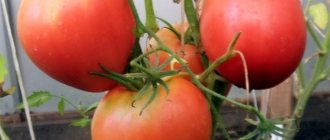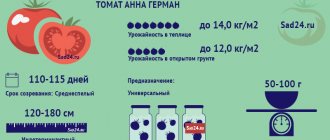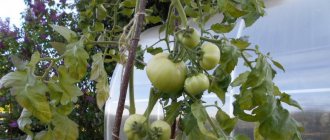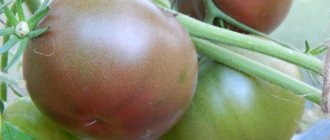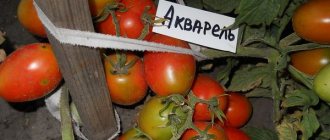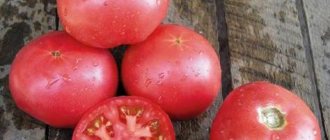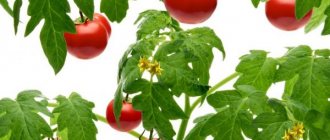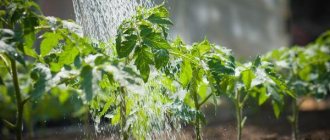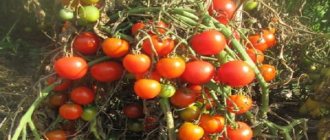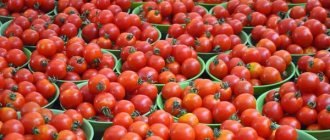Description of the variety
Summer residents of the southern regions grow tomatoes in the open air, while representatives of the north of the country and the middle zone prefer to plant the Princess in greenhouses or hotbeds. The variety loves fertile soil and fertilizing.
The bushes are indeterminate and are not limited in growth. Princess is a mid-season variety , and is characterized by high yields.
Distinctive features
The bushes grow up to 1.5 m high. Most often they require staking and pinching, since the fruits are large and heavy. The plant is formed into 2 stems. The foliage is medium, the leaves resemble potato leaves in appearance. The bushes are powerful and have a developed root system.
Fruit characteristics, yield
Smooth tomatoes have an oval shape and thick skin. The color is rich red, the aroma is classic. The average weight of a tomato is about 200 g, in greenhouse conditions the figures increase to 400 g. If you follow the rules for caring for 1 square meter. m harvest about 14 kg of juicy tomatoes.
Features of care
One of the advantages of the described variety of tomatoes is considered to be simplicity and undemanding care, which consists of timely watering, fertilizing, forming bushes and weeding.
Did you know? From a botanical point of view, tomatoes are polycarpous berries, although
in 1893 a court in America recognized them as vegetables. However, since 2001, the EU states have ordered the return of tomatoes to fruit status.
Fertilizer and watering
The “Princess” variety is characterized by a fairly high growth rate, so it needs good, abundant watering and fertilizing. Irrigation of the bushes should be carried out 2-3 times a week, until the top layer of soil is completely wet. It is recommended to moisturize in cloudy, morning or evening times, in order to avoid possible burns of foliage from exposure to direct rays of the sun. Cold water should not be used for irrigation. Tomatoes require mandatory moisture during the flowering period, after loosening the soil and during the fruit ripening phase.
In greenhouse growing conditions, to irrigate crops, experts advise organizing a drip irrigation system, which allows you to control the level of moisture. For full plant growth and fruit formation, it is necessary to regularly feed the bushes using organic matter (litter, manure) or mineral products based on phosphorus, potassium or nitrogen. Fertilizers need to be applied once every 30 days, combining them with watering. The plant especially urgently needs feeding in the phase of fruit formation and development.
Find out what and how to properly feed tomatoes during flowering and fruiting.
Bush formation and pinching
After rooting the plants, it is necessary to form bushes and trim the stepsons, otherwise you should not hope for a rich harvest. As a rule, a bush is formed:
- In 1 stem. To do this, all lateral shoots are removed, and the stem is tied to a trellis or wooden pegs. The lateral stepsons are trimmed when they reach a size of 5–6 cm. The stepsons are removed every 10 days. At the same time, the first flowering cluster is pruned, which reduces the load on the bush and increases productivity.
- In 2 stems. Formation according to this scheme is carried out during the process of growing seedlings. To do this, when the sprouts form a second full leaf, pinch off the top of the main stem. Stopping the growth of the main stem will allow lateral shoots to develop, which can later replace it. You can also shape the bush after planting the seedlings - in this case, the plant is left with 1 dense stem and 1 side, the strongest shoot, on which 5 flower clusters have formed.
Loosening the soil and weeding
A mandatory procedure when caring for the Princess variety is considered to be loosening the soil and weeding from weeds. The first event allows you to:
- saturate the soil with oxygen and nutrients;
- create favorable conditions for warming up the soil;
- intensify the growth of culture.
You will be interested to know what a tomato is: a berry, a fruit or a vegetable.
The first loosening is recommended to be carried out immediately after planting, going 10–12 cm deep into the soil. Subsequent loosening procedures are carried out after watering to a depth of 4–5 cm. Weeding is recommended to be done as needed. However, it is important to do this before the weeds begin to bloom.
To prevent the appearance of parasitic plants, it is recommended to cover the bed with tomatoes with a layer of mulch - sawdust, straw, hay. Mulching will also make it possible to retain moisture in the ground and protect the plant from possible negative climatic phenomena, and will simplify the process of watering the bushes.
Diseases and pests
The Princess variety is characterized by good resistance to diseases and pests that most often affect plants of the Solanaceae family. However, failure to comply with the basic rules of agricultural technology can lead to damage to the bushes by tobacco mosaic, gray spot, and late blight.
To prevent the development of diseases it is necessary:
- avoid over-wetting the plant, which can cause rotting of the root system, drying out and yellowing of the foliage;
- regularly loosen the soil and weed;
- be sure to observe crop rotation;
- apply fertilizers at the specified time;
- Periodically disinfect the bushes using biological products, for example, Fitosporin, which protects tomatoes from fungal infections and viruses.
How to grow seedlings
Seedlings are prepared 55-60 days before planting the plant on the site. For the best harvest, gardeners are advised to follow basic agrotechnical rules.
Seed preparation
High-quality seeds are the key to a good harvest. When purchasing material, inspect it carefully for stains and other uncharacteristic signs. Buy seeds only from trusted places.
The main stage of seed preparation is germination. Before doing this, harden them by placing them in the freezer for 10 hours. Low temperatures destroy larvae and dangerous microbes. Then disinfect the seeds by placing them in a solution of potassium permanganate for 15 minutes. Hydrogen peroxide is also suitable for this.
Sprout the seeds in damp gauze or a cotton pad. For convenience, place them on a plate and place them in a warm and dry place. Germination will show the overall germination of seeds and will also speed up the appearance of the first shoots.
Important ! For the most powerful effect, use “Solution”. This universal plant remedy kills harmful microorganisms, saturates the seeds with essential microelements, and helps to quickly adapt to external conditions. “Solution” is sold in any gardening store.
Container and soil
To save time and effort, gardeners purchase ready-made soil in the store, for example, “Universal” soil or “Krepysh” mixture. Their compositions are already enriched with all the necessary elements and correspond to the required acidity level. Such soil is an ideal soil for seedlings.
Any container for seeds can be used, for example, plastic cups or flower pots. The main thing is that the container is dry and clean. Stores sell special plastic cassettes and containers for seedlings.
Sowing
We list the stages of planting seedlings:
- pour soil into the container, filling 1/2 of the container;
- make small grooves about 1 cm deep;
- put seeds in each;
- sprinkle soil on top and gently pat down;
- pour in plenty of warm, settled water (never from the tap);
- cover the top with a lid or cling film;
- make a marking (write the date and name of the variety on a sticker), so it will be easier for you to navigate by planting time.
Growing and care
The growth of seedlings depends entirely on proper care:
- Compliance with light conditions. Place the containers in the brightest place in the house, for example, on a windowsill or loggia. The recommended light level is at least 14 hours a day. If there is a shortage, arrange additional lighting with fluorescent lamps.
- Watering mode. Tomatoes are watered for the first time 10 days after planting. Make sure there is not too much moisture, otherwise the risk of fungus and infections will increase. Water should get directly under the root, bypassing the stem and leaves.
- Temperature conditions. The ideal air temperature is at least 22 degrees. Harden off the seedlings 2 weeks before planting the seedlings in the ground. For example, place it on the balcony every day, increasing the hardening time. First it will be 1 hour, then 1.5 and so on. Hardening creates immunity in tomatoes to sudden weather changes. This is especially true for gardeners who grow Princess in open ground.
- Fertilizers . The first fertilizing is applied after 15 days. To do this, use liquid chicken manure or a solution based on garlic and onion peels. In the future, fertilizers are applied at intervals of 15-20 days. In addition to organic matter, do not forget about mineral nutrition in the form of nitrogen-containing substances.
Important ! At the seedling stage, it is important to create favorable conditions for tomatoes to develop. Use growth stimulants: “Silk”, “Epin-extra”, “Zircon”. These drugs will give the Princess the necessary amount of potassium and phosphorus, develop immunity to diseases, and increase productivity.
Description of fruits
Now it’s worth briefly talking about the fruits of the “princess” tomatoes, photos of which are attached to the article. After all, it is for their sake that summer residents spend a lot of time and effort, working hard in the beds.
The fruits are quite large - on average from 150 to 250 grams. With good care, the first fruits formed on the bushes can reach an enormous weight - up to 450 grams. But their number is usually small. The taste is excellent. High sugar content is successfully combined with fleshy pulp, which makes tomatoes a good choice for preparing salads, winter marinades, ketchup and tomato juice.
The skin is quite thin and smooth - the color is deep crimson or red. However, it is precisely because of the thin stone that the fruits are not suitable for long-term storage, and also do not tolerate transportation over long distances. For some summer residents who have to drive for many hours on a bad road, this can be a serious drawback - some of the tomatoes, alas, will probably be spoiled during transportation.
How to grow tomatoes
The Princess is unpretentious in care; even a novice gardener can reap a good harvest.
Landing
The morning or evening of a cloudy and windless day is perfect for planting. Plant the bushes at a distance of 50 cm from each other. Immediately near each bush, place a wooden peg for the future garter. Place the seedlings in the ground carefully, without harming the still fragile stem. After all the seedlings are in the beds, water them generously with warm water.
Care
Caring for the Princess variety is as follows:
- Watering mode. Water the bushes every 7-10 days. If the summer is rainy, reduce the amount of water; if it is hot and dry, on the contrary, increase it. It is better to water the tomatoes in the morning or evening, when the sun is not very hot - this will prevent sunburn. Plus, it is recommended to avoid getting moisture on the bushes, since bacteria and microbes develop especially actively in conditions of high humidity.
- Loosening the earth . Loosen the soil every 10-12 days, this rule is especially important when applying fertilizers. The procedure saturates the soil with oxygen and makes it more airy.
- Removing weeds . Extraneous grass especially likes to appear after rains. Weeds feed on tomatoes, which is why the latter lack the strength to develop. Remove weeds with bare hands or gloves as they grow.
- Gartering of bushes is required when the first tomatoes form on the clusters. For the garter, in addition to wooden stakes, you will need twine. When tying up bushes, be sure that the twine does not injure the stem. Also, never tie the twine around the stem more than once.
- Plant tomatoes every 7 days. Plants form additional shoots (stepchildren), which take some of the nutrients from the tomatoes. When removing them, it is important not to damage the stem. If the shoots are still small, use scissors.
- Fertilizers for tomatoes. Wood ash, milk, eggshells, liquid mullein, and aloe juice are suitable organic fertilizers. Among the chemicals – “Fundazol”, “Kornevin”, “Rival”. To achieve the best effect, gardeners recommend alternating fertilizing.
Features of cultivation and possible difficulties
Before planting a crop, pay special attention to disinfecting the soil. In the fall, collect all the garbage and plants and burn them. Dig up the beds and place a “blanket” of hay on them. In the spring, 2 weeks before planting, water the soil with a manganese solution. If you plan to plant tomatoes in a greenhouse, treat the structure with the solution: walls, doors, windows, and so on.
Also, do not forget about foliar feeding. We are talking about spraying bushes for preventive purposes. For example, Bordeaux solution, consisting of water, lime and copper sulfate, is recognized as an effective remedy against pests. Spraying with the product is carried out three times per season. The strong effect of the drug normalizes metabolism and helps avoid infections. Before working with the solution, be sure to prepare gloves, protective clothing and goggles.
Diseases and pests
Princess tomatoes may develop blackleg or root rot. The infection penetrates deep underground and destroys the roots, slowly “eating” them. As a result, the bushes do not receive nutrition from the soil and die. For prevention purposes, use a solution based on milk or whey. Such sprays are safe for both plants and humans.
Other enemies of roots are wireworms and mole crickets. Pests also penetrate deep underground and destroy roots. The leaves fade, turn yellow or white, and the development of tomatoes slows down. For prevention purposes, use eggshells. Just scatter it on the garden bed, and the tomatoes will be under reliable protection.
Important ! The Princess variety has high immunity to common fungal diseases - late blight and septoria. This is one of the main advantages of tomato.
What does the "chemical" detail of the name mean?
The mysterious element of the name often frightens inexperienced gardeners who have not had time to understand the scientific component of the variety’s characteristics. One of the letters of the Latin alphabet and a number are often found on seed packaging; F1 is a sign of the hybridity of the variety.
The letter F came into the names of numerous varieties from the Italian language; it is with it that the word “Filli” begins, translated as “children”. The numeral in this case is interpreted as “first generation”.
A short note on the packaging indicates that the unique variety was born through the process of crossing two different subspecies of the plant. Such seeds have a number of advantages, including:
- Resistance to dangerous diseases and prolonged absence of water.
- Incredible endurance, which allows emerald bushes not to succumb to the attacks of parasites.
- The fruits are juicy and large, because hybrids embody a successful mixture of the best characteristics received from the parents.
- In addition, the plant will bear fruit under any circumstances, even if the weather conditions are shockingly unsuitable for growing tomato varieties.
The disadvantages of hybrid tomatoes are not so numerous, among them:
- the cost is higher than that of ordinary seeds;
- it is impossible to obtain hybrid seeds from already ripened fruits; the results of growing such tomatoes can be disastrous;
- It is possible to cross different subspecies of tomato only in the laboratory; summer residents cannot cope with the complexity of the heterosis procedure.
When buying such seeds, you should rely on the integrity of the manufacturer. Often, under the guise of elite F1s, classic subspecies that do not have the enviable characteristics of hybrids are sold.
See also
Description of the tomato variety Golden Brush, features of cultivation and careRead
The nuances of growing in open ground and in a greenhouse
When growing in open ground, the best place for planting is eggplant or cucumber beds. Do not plant tomatoes after potatoes and peppers. For the Princess, select the brightest and most spacious place in the garden. Avoid being near the above-mentioned potatoes. The best neighbors for tomatoes are legumes. In addition, gardeners advise planting basil or marigolds next to vegetables. It has been established that they improve the taste of tomatoes.
If tomatoes are planted in a greenhouse, do not forget to ventilate it regularly. The fact is that the structure is characterized by high humidity and high air temperature, which negatively affects the development of tomatoes . Ventilation is provided through vents and open doors.
Important ! Use a drip irrigation system both in the greenhouse and in the open ground. It directs water directly to the roots, bypassing the stems and leaves. Root fertilizers and top dressing are also applied using a drip system.
Features of the variety
First of all, it is worth characterizing the “princess” tomato. It is perfect not only for greenhouses, but also for open ground - provided that seedlings are used. The yield is quite high - on average, 13-14 kilograms of ripe fruit can be collected from one square meter, which is a very good indicator.
Ripening time is about 100-110 days after the appearance of the first shoots.
The bushes are quite tall - about 150-160 centimeters. Therefore, it is very important to use a garter so that they do not fall under the weight of the fruits - in this case, there is a high probability of rot, especially if mulch is not used in the beds. You also need to shape the bushes to achieve better yields.
Harvesting and application
The Princess is harvested immediately after the first ripe tomatoes appear. You can tell when vegetables are ready to harvest by their characteristic rich red color. Tomatoes are collected so as not to damage the stalk. Over-ripening of tomatoes is undesirable, otherwise it will have a bad effect on the overall yield.
Tomato is rich in amino acids, vitamins and minerals. Positively affects the nervous system and the gastrointestinal tract. In addition, tomato is a natural antioxidant.
Tomatoes are used in the preparation of many dishes: pasta, tomato juice, vegetable stew, pizza. Vegetables go well with other foods - meat, poultry or fish.
Growing seedlings
The seedlings do not require special care. Immediately after planting, the soil must be moistened and covered with polyethylene or glass, put in a warm place - the optimal temperature is +25 degrees Celsius. In a few days the first shoots will appear. After this, the glass or polyethylene is removed, and the seedlings are placed on the windowsill, preferably on the sunny side. The more light the sprouts receive, the better.
But at the same time, you need to protect the seedlings from excess heat, otherwise they will simply dry out, despite abundant watering.
The soil is moistened as needed. Small amounts of nitrogen fertilizer can be used to stimulate leaf development and stem growth.
Reviews from gardeners
Summer residents say different things about the Princess variety:
Valentina, Stavropol: “The quality corresponds to the stated characteristics. There are few seeds, the pulp is juicy and sugary. The yield is average, the taste is delicate. I will grow more."
Alla, Penza: “I planted the varieties for the first time 3 years ago. In the greenhouse, the bushes have grown to 1.7 m. The fruiting period is extended, the yield is high. I use it for winter preparations or pickling.”
Nikita, Moscow region: “The Knyagina variety is tasty, but I was not satisfied with the yield. The tomatoes took a long time to set, the fruits were watery. I doubt that I will plant the Princess variety again.”
Recommendations for using the variety
Tomatoes of this variety have excellent taste, which are rated 4 points out of 5 by vegetable growers. That is why the fruits are widely used raw, as a raw material for preparing salads, appetizers, vegetable dishes, sauces, and ketchups. They are suitable for canning and pickling, and preparing salad preserves. Thanks to their rich taste, meatiness and pleasant aroma, these tomatoes add piquancy to cooked dishes.
We recommend that you find out what you need to do to make tomatoes turn red faster.
“Princess” is rightfully considered one of the best varieties of medium-ripening tomatoes, with consistently high yields. These tomatoes are undemanding in care and cultivation, are not afraid of changes in temperature, and are resistant to many diseases. The described crop will be an excellent promising option for beginning gardeners.
Description and characteristics of the variety
The tomato hybrid Princess prefers greenhouses, where it produces the greatest yield, but can also be grown in open ground. The plant is quite strong and unpretentious. The bushes are powerful, 1.5-1.6 m high. They have medium branches, covered with large leaves. The inflorescences are simple. The first fruits can be harvested 100-110 days after germination.
The fruits are large, steak-shaped, weighing on average 150-250 g, although tomatoes up to 450 g can form on the first clusters. They have a cylindrical shape (other gardeners describe it as heart-shaped) and red skin. The pulp is fleshy, tender, quite sweet. It can be used for any culinary purposes, but the largest fruits are difficult to preserve.
Tomato
Home comfort April 6, 2017
Tomato is everyone's favorite vegetable. It contains useful substances necessary for the body and has a pleasant taste. This culture has many varieties, one of which is the “Lentyayka” variety. Read about the cultivation, advantages and disadvantages of this variety in the article.
Tomato "Lazy": description of the variety
The tomato belongs to the Solanaceae family and is the closest relative of the potato. This variety was bred by Siberian breeders and is rightfully considered a people's favorite. Tomato “Lentyayka” is an early, productive variety with low bushes and large fruits that ripen 95–100 days after planting. It is grown both in open ground and under film cover.
The pinching continues until the first brush appears. A tomato of this variety has an interesting feature - the formation of a large number of fruits occurs on numerous lateral stepsons.
The vegetable has a high yield. From one bush you can collect up to four kilograms of large, tasty, bright red fruits weighing up to three hundred grams.
The tomato has a round, smooth, heart-shaped shape and tender, sugary pulp.
Advantages and disadvantages of "Lazy" tomatoes
Tomato "Lazy" is endowed with the following advantages:
- High yield.
- Active fruiting.
- Beautiful appearance.
- Long shelf life.
- Wide range of uses.
- Strong immunity.
- High frost resistance.
The Lazy Man tomato is not without its drawbacks. Here are some of them:
- Plants cannot tolerate extreme heat.
- They need strong support.
- Demanding on soil composition.
Video on the topic
Growing tomatoes in seedlings
Some summer residents who devote a lot of time to growing vegetables prefer this method. They grow seedlings for their own beds.
Before planting seedlings, stakes are driven into the ground at a distance of one meter from each other, and a rope is pulled along which holes are dug.
Seedlings are planted in them, which must be tied to a rope stretched between the stakes.
The lower leaves of the seedlings are removed, leaving only the upper ones (several pieces). Then the cup with the seedlings is turned over, the plant is removed from it along with the soil and transferred to the hole. After this, it is sprinkled with earth and watered abundantly so that the soil is compacted.
Immediately after planting, the ground around the plant trunk is mulched with leaves, manure or sawdust. This will save the owner from loosening the soil and weeding. The layer should not be large, ten centimeters thick is enough. Thanks to mulch, the root system does not overheat and does not dry out. The mulch will begin to rot over time, while simultaneously saturating the soil with nutrients.
Growing tomatoes without seedlings
Many summer residents prefer to have Lazyka tomatoes on their plot. Growing vegetables in seedlings is not always included in the plans of the owners, as it takes a lot of time. What to do if you want to grow a Lazy Tomato, which has the most positive reviews? There is a way out - plant tomatoes directly in the ground.
Tomato Sovereign F1 - description and characteristics of the variety
Characteristics of the variety
Agricultural specialists have created a considerable range of salad-type tomatoes. And Sovereign F1 occupies a decent place in it. Gardeners choose it for its excellent data. It’s not a force that summer residents want to receive a guaranteed harvest, regardless of the effort of cultivation. And this tomato allows us to talk about such an approach.
- Early dichogamy, the first fruits can be tasted already on the 100th Saturday from germination.
- Created for ground plantings, for unheated film greenhouses.
- Determinate like, there is a limitation in growth, usually the height of the plant does not exceed 90 cm.
- The corrugation is medium-sized, dark green, foliage is moderate.
- The formation of the bush is small: little is required, it has limited growth potential.
- Up to 4 fruit clusters are formed on one stem.
- The weight of the fruit reaches 180 g.
- Productivity per square meter after 16 kg, subject to agricultural technology.
- Genetically resistant to Alternaria, Stolbur, TMV, late blight, Fusarium wilt.
The tomato has the status of “author’s” and is included in the State Register of Vegetable Crops of the Russian Federation. Suitable for growing within private household plots, as well as in private gardens.
Virtues of fruits
Often, early varieties, along with the keeping quality of a bountiful harvest, have a sour taste and dryish pulp. The same tomato collected decent quality fruits of tomato species.
- Gifts of pomona are smooth, pleasant to the touch, glossy.
- The tomatoes are beautifully round in build with an elongated “spout”; there is slight ribbing at the stalk of large fruits.
- They are impressive in size - up to 180 grams, juicy, sugary, meaty.
- An increase in sugar levels is noted.
- Ripe fruits have an appetizing yellow-red color and have a bright, “tomato” aroma.
- The skin of the fruit is dense and does not crack during ripening and transportation.
- Ripe tomatoes are well transported without losing their presentation, and are stored outside the refrigerator for quite a long time, up to one month.
- Green fruits can be successfully ripened at home.
- The eggs are the same size and do not get smaller.
The tomato is suitable for fresh salads, for the preparation of tomato paste, ketchup, juices, and pulp. Possible canning in parts, use in salads - assorted. The preparations are obtained with a sweet taste.
Growing position
It is not difficult to get a good harvest, as stated in the description of the crop, take a bag of seeds, if you follow the simple, traditional routine for tomatoes. The following recommendations from specialists must be followed:
- Create seeds for seedlings no later than the second half of Martha - the 15th - 25th.
- Treat seedling boxes with a pink potassium permanganate solution.
- Use fertile, light soil, or better yet, a ready-made soil mixture for nightshade crops.
- Bury the seeds into the soil no more than 1 cm.
- Maintain a soil temperature comfortable for seed germination - 23 - 25 degrees Celsius.
- After mass shoots appear, increase the temperature to 18 degrees Celsius.
- If there is insufficient natural light, add additional light to the plants.
- Sometimes two true leaves will grow, so cut the seedlings into separate cups with a capacity of at least 100 ml.
- Before planting in a greenhouse or bottom, plants should be hardened off to reduce stress and improve adaptability. To do this, the seedlings are briefly placed in a cooler area, loggia, or veranda. The time spent there is gradually increased.
- Prepare a place for future planting in advance so that the soil settles and remains loose and moist; fertilizers are added to the holes according to the recommendations on the package.
- Seedlings are planted in open ground when there is no threat of return frosts.
- Plantings must be shaded from the bright sun with white non-woven material.
- The covering medium is also useful in case of cool weather or early planting.
- The bushes will require support when the crop is forming, so even during planting it is necessary to introduce pegs or provide another garter option.
- Mulching with rotted organic matter has an advantage in comparison with dark non-woven material; in the first case, it both retains moisture and provides additional nutrition for horses.
Watering should be moderate, and before mass ripening it should be reduced to a minimum, just to prevent the soil from drying out, because the tomato root system is superficial. It is possible to alternate watering and loosening, or regularly mulch the soil.
The tomato is demanding of heat and sunlight; if they are lacking, the fruits will be less tasty and sweet.
Description of the aristocratic tomato Princess and rules for growing a hybrid variety
The Princess tomato has an elegant fruit shape and exquisite taste. It has long won the hearts of home garden lovers and pickle gourmets. After all, tomatoes are well digestible both raw and after heat treatment. Everyone who planted this variety notes its versatility and unpretentiousness.
Agrotechnical indicators
The species is included in the Russian State Register for Growing Tomatoes. Fleshy, oval-shaped tomatoes are sold out instantly at any price in early spring or sultry summer, when competition and an abundance of products reign on the shelves. If the “princess” is grown in her own garden, then the housewife can equally well prepare a salad, squeeze out aromatic juice or bake the fruits in the oven with other ingredients.
The characteristics and description of the variety introduce the theoretical basis developed by specialists. Without this, it is impossible to judge the prospects for the harvest, especially in mass production. The plant is a hybrid, indeterminate, mid-season, high-yielding tomato.
Often the name of a vegetable includes the Latin letter f followed by the number 1. These symbols indicate the hybridity of the first generation variety. It was obtained as a result of cross-pollination of two subspecies of plants. They have both positive aspects and certain disadvantages.
Among the advantages of hybrids are the following:
- immunity to dangerous infections;
- ease of care;
- drought resistance;
The negative aspects include:
- high cost of seed;
- lack of grains suitable for growing the next generations of the plant;
- the possibility of crossing only in special conditions of scientific laboratories.
Summer residents trying to cope with the task of heterosis on their own will not get the expected results. Therefore, when purchasing hybrid seeds, you only need to rely on the integrity of the manufacturer. There are precedents when traditional tomatoes with insufficient qualities are sold under the guise of hybrids.
The height of the bush can reach 1.5 m, so it is impossible to do without tying it to pegs or to a high horizontal trellis. It is also necessary to remove excess side shoots, of which there can be a lot. This is done so that the plant’s energy goes more towards the formation and ripening of fruits.
Rules for planting and caring for plants
The description would be insufficient without mentioning the rich, bright red hue of the fruit, the taste of which is literally felt through the smooth skin. Tomatoes thrive in greenhouse conditions and produce excellent yields on unprotected soil, subject to agrotechnical requirements and favorable weather. In figures, the yield ranges from 12 to 15 kg per 1 m². To obtain such a quantity of fruits, seed sowing begins 90 days before transplanting the seedlings into open ground.
Formation of a tomato bush Princess
After rooting of the transplanted plants, the formation of bushes and pruning of stepsons will be required. This will prevent thickening of the plantings, increase the illumination of the plants and the supply of oxygen to all parts of the above-ground part. The procedure is especially relevant for tomatoes grown in greenhouses and greenhouses.
In one stem
This is a classic scheme, according to which all the stepsons are removed, and the main stem is tied to a trellis or stakes. The first stepson of indeterminate tomatoes usually appears in the axil of 6–8 leaves. Removal of side shoots is carried out when they reach a length of 5 cm with an interval of 10 - 15 days.
At the same time, the first flowering cluster is removed to increase yield and accelerate the onset of fruiting. Lightening the bush - removing all the vegetative mass until the next flowering cluster is performed to reduce the load and save nutrients.
On a note! In favorable conditions, the Princess tomato produces up to 8–10 fruit clusters, on each of which up to 5–9 fruits are formed.
In two stems
Typically, forming tomatoes into two stems is practiced with determinate species, but since Princess is a hybrid, this method has shown the best results. The easiest way to form according to this scheme is at the stage of growing seedlings.
When the seedlings have formed a second true leaf, the top of the central stem is pinched. The stem stops growing, and at the same time lateral shoots appear from the axil of the first and second leaves. They will become the new conductors and replace the main stem.
If the formation of two stems is carried out after transplanting the seedlings into the ground, the scheme changes slightly. The plants are left with a central stem and the strongest lateral shoot after the formation of the fifth flower raceme, the remaining stepsons are removed, and the lower part of the plant is lightened.
The abandoned shoot will become a continuation shoot when the main stem stops growing. Stepchildren of the second level will also form on it; they must be removed.
Each method of forming two stems has advantages. Seedlings tolerate the pinching procedure more easily and recover quickly. In addition, this option reduces the time before fruiting begins. The formation of adult tomatoes will increase these times, but the fruits will ripen almost simultaneously.
Otherwise, caring for Knyaginya tomatoes does not differ from other large-fruited varieties of indeterminate type.
Growing the best varieties of tomatoes in seedlings: description and reviews
1001fermer.ru > Vegetables > Growing the best varieties of tomatoes in seedlings: description and reviews
Tomato has long been known to people as a vegetable that can be eaten. But even earlier it was valued simply for decorative purposes to decorate the interior and nothing more.
Tomatoes are a herbaceous plant; they can be either annual or perennial, depending on the variety. Seedlings are grown from seeds.
To get a good harvest, vegetable growers recommend using the best varieties of tomatoes.
Features of ripening and characteristics of varieties
Tomatoes ripen in different ways; in order to enjoy delicious sweet fruits throughout the summer season, from the beginning to the end of the season, you need to plant different varieties.
Description of the Northern Beauty tomato variety, its cultivation and care
When selecting tomato varieties for canning, gardeners should pay attention to the Northern Beauty tomato. Among the abundance of ordinary and hybrid species, tomatoes of this type stand out for their high yield and excellent taste.
What else is remarkable about the variety?
Description of the variety
Northern beauty is a mid-season indeterminate variety. The height of the bush is 140–150 cm. From the moment of seed germination to the ripening of the fruit, 118–120 days pass. The plants are covered with medium-sized leaves of the appropriate shape for tomatoes. The color of the stem and leaves is green.
Fruit characteristics:
- Unripe tomatoes are light green, the area around the stalk is dark green.
- Upon reaching technical maturity, the fruit turns deep pink.
- Inside the tomatoes, covered with smooth thin skin, there are 5-6 seed chambers.
- The pulp is dense and juicy.
- The taste is distinctly sweet.
- The shape of the fruit is elongated cream with a cone-shaped pointed tip.
- 5–6 tomatoes are formed from the inflorescence.
The weight of a tomato ranges from 60 to 120 g. Thanks to the fleshy core, the fruit is perfect for preparing canned whole fruits and eating fresh. Subject to the correct watering and fertilizing scheme, as well as normal weather conditions, the plant yield is 4.1 kg per 1 sq. m. beds.
The Northern Beauty tomato variety is resistant to dangerous diseases such as fusarium and TMV. The bushes tolerate long droughts and cold snaps well.
In view of these features, tomatoes grow well throughout Russia, including the northern regions. Tomatoes of this variety are suitable for growing in greenhouses and open ground.
Features of cultivation and care
In order for all the characteristics to manifest itself in practice, planting and subsequent manipulations must be carried out according to the established plan. To obtain seedlings, seeds are sown in seedling boxes 50–55 days before planting in the garden. To speed up seed germination, cover the container with plastic film or glass.
Until the sprouts appear, the cover is periodically removed. If you keep the crops covered, growing delicious tomatoes will be a disaster: the soil will become moldy and the seeds will not germinate.
Seeds are sown in furrows to a depth of 1 cm. After germination, excess plants are removed or planted in separate cups after the formation of 2-3 true leaves. Young plants are planted in a permanent place after the formation of 5–6 true leaves. Plant seedlings in cloudy weather or in the evening.
According to the description of the variety, the height of the bushes is about 1.5 meters. Plants of such large growth are usually tied to supports. Being in an upright position, the plant gets sick less often, since the fruits do not come into contact with the soil, and the bushes are well lit and ventilated. In addition, thanks to the correct distribution of nutrients, formed bushes bear fruit better than their creeping, unkempt counterparts.
Caring for tomatoes completely coincides with the generally accepted care for all types of vegetable crops. The bushes are regularly watered and fed with organic fertilizers.
Have you grown a Northern Beauty tomato? What are the advantages and disadvantages of this variety? Your opinion will help those who still have doubts make their choice, because reviews based on life experience are much more important than stereotyped characteristics.
Tomato Superexotic - description and characteristics of the variety
Playback
- Culture belongs to the indeterminate species, that is, it grows constantly.
- Leaves of something (in short, the bush is considered non-leafy.
- Refers to mid-season varieties - Fruit ripening period is from 105 to 115 days.
- There are many nests in the brush; it is formed after 6 to 20 berries.
- Tomatoes are very shaped like plums.
- There are two types of color - either dark - dark red or brownish.
- On the surface there are stains and stripes of dark green tones.
- The film is strong and thick, thanks to which the berries are preserved during transportation.
- The gravity is pleasant, sweet with a slight sourness, the smell is tomato.
Seedling
This fancy variety is grown by seedlings. You can prepare the soil yourself - take the usual lining from the garden, mix it with peat and humus, add a little compost.
Seeds should be planted 60 days before vegetables are planted in the garden. They are pre-treated with a weak solution of potassium permanganate, washed and dried. Afterwards, they are laid out on moistened soil and sprinkled with a half-centimeter layer of dry sand on top. The steam container is covered with a piece of glass and placed where it is warm. Sprouts will begin to appear on the fourth or fifth day.
To prevent seedlings from stretching, it is recommended to follow the following rules:
- When the seeds germinate, the temperature must be maintained within 20-22 degrees.
- Store boxes with seedlings in the brightest place - for example, on a window. Whereas the sprouts require a lot of light, it is recommended to shine them with lamps in the evenings for about 3 or 4 more hours.
- Water the seedlings as often as necessary - as soon as the soil dries out and dry ice forms.
- Two to three weeks before planting, the seeds are hardened, acclimating them to outdoor conditions.
- When one or two leaves appear on the seedlings, they are picked and placed separately in a separate container.
Planting on the site
The grown seedlings are transplanted closer to the next half of May - at this time favorable weather sets in. The place for landing is selected in such a way that the red price falls on it on the market day of light. It is not advisable to grow Superexotic in the same place where other nightshades were located last year. The best places for growth are where cucumbers, carrots, eggplants and zucchini used to grow.
If a crop is planted in a greenhouse or greenhouse, then it is better to place it in 4 pieces per square meter. Part is carried out in one stem. Tomatoes grown outside are planted slightly less often - 3 bushes per 1 square meter are enough, which is why in this case the bush is formed into 2 or 3 trunks. Be sure to make a tapestry for the garter, otherwise there is a high risk that the bushes will break due to the weight of the fruit.
- Watering is carried out 4-5 times a week with warm water. It is advisable to deliver water to the roots without getting on the leaves.
- Loosening the soil should be carried out at least twice as much per month - this will ensure that the necessary portion of life-giving air reaches the roots.
- After the plant is formed, you need to remove the shoots from time to time - grown shoots and leaves on the upper and lower parts of the bush. Then the plant will give its strength to the fruits, and the unimportant (= unimportant) will spend on unnecessary mass.
Top dressing
This tomato needs to be fed with Vodan or twice a month. Feeding during flowering and fruit set is very important. They are equally suitable as mineral fertilizers, as well as organic ones. Organic materials include cow manure and bird droppings, and compost is prepared from grass and plants.

